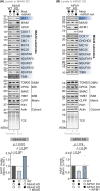Interaction with the cysteine-free protein HAX1 expands the substrate specificity and function of MIA40 beyond protein oxidation
- PMID: 39564806
- PMCID: PMC11653687
- DOI: 10.1111/febs.17328
Interaction with the cysteine-free protein HAX1 expands the substrate specificity and function of MIA40 beyond protein oxidation
Abstract
The mitochondrial disulphide relay machinery is essential for the import and oxidative folding of many proteins in the mitochondrial intermembrane space. Its core component, the import receptor MIA40 (also CHCHD4), serves as an oxidoreductase but also as a chaperone holdase, which initially interacts with its substrates non-covalently before introducing disulphide bonds for folding and retaining proteins in the intermembrane space. Interactome studies have identified diverse substrates of MIA40, among them the intrinsically disordered HCLS1-associated protein X-1 (HAX1). Interestingly, this protein does not contain cysteines, raising the question of how and to what end HAX1 can interact with MIA40. Here, we demonstrate that MIA40 non-covalently interacts with HAX1 independent of its redox-active cysteines. While HAX1 import is driven by its weak mitochondrial targeting sequence, its subsequent transient interaction with MIA40 stabilizes the protein in the intermembrane space. HAX1 solely depends on the holdase activity of MIA40, and the absence of MIA40 results in the aggregation, degradation and loss of HAX1. Collectively, our study introduces HAX1 as the first endogenous MIA40 substrate without cysteines and demonstrates the diverse functions of this highly conserved oxidoreductase and import receptor.
Keywords: HAX1; IMS; MIA40; mitochondria; mitochondrial disulphide relay.
© 2024 The Author(s). The FEBS Journal published by John Wiley & Sons Ltd on behalf of Federation of European Biochemical Societies.
Conflict of interest statement
The authors declare no conflicts of interest.
Figures




References
-
- Herrmann JM & Bykov Y (2023) Protein translocation in mitochondria: sorting out the Toms, Tims, Pams, Sams and Mia. FEBS Lett 597, 1553–1554. - PubMed
-
- Busch JD, Fielden LF, Pfanner N & Wiedemann N (2023) Mitochondrial protein transport: versatility of translocases and mechanisms. Mol Cell 83, 890–910. - PubMed
MeSH terms
Substances
Grants and funding
LinkOut - more resources
Full Text Sources
Miscellaneous

